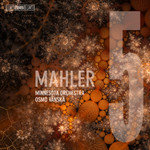|
Back
07/25/2017
Gustav Mahler: Symphony N° 5 in C-Sharp minor
Michael Gast (horn), Minnesota Orchestra, Osmo Vänskä (conductor)
Recording: Orchestra Hall, Minneapolis, Minnesota (June 2016) – 75’30
BIS-2226 SACD – Booklet in English, German and French (Distributed by Naxos of America)

   
Having recorded Beethoven’s symphonic cycle in 2004 under the BIS label, Minnesota Orchestra’s music director, Osmo Vänskä, returns to begin yet another enthusiastic undertaking: the Mahler series. Steps to capture Mahler’s numerical sequence may seem logical enough, though this presumption rests. Move gears forward to the Symphony N° 5 as Maestro Vänskä’s first selection which proves strategic when placing the composition in context of a youthful Mahler.
While living in Iglau, Mahler experienced a dazed array of polyphonic music that was captured in his ever-expanding mind. At the time, the status quo generally bristled at his musical eccentricities...clearly Mahler was brilliantly on another planet. The generalized struggle between “low-life” and “high art” music is precisely the unsettledness Mahler wanted to create. The Minnesota Orchestra makes sense out of these stubborn exertions by carrying a forwarding, meaningful cerebral concept.
Michael Gast’s opening clarion horn resonates with machine gun precision (“Tauermarsch”) to unveil the strings’ Bohemian dirge planted within a well-suited Vänskä tempo with slumbering forwardness and a plodding Salome-esque sullenness. These two fractured idées are smartly crafted.
A big question mark remains poised upon the conclusion of the ensuing tempestuous “Stürmisch bewegt” after being theatrically driven to battle by brass outcries with threads of woodwinds via oboe, flute and violin flourishes. Osmo Vänskä’s dynamics are never outrageous, yet in this segment the tussling forces could radiate grander severity.
Osmo Vänskä dictates change, movement by movement. The middle division, “Scherzo”, pops with flouncy violins, set against contrapuntal harmonies that elicit feelings of platonic waltz cadences. Here’s where the Minnesota Orchestra excels with grand demeanor without extenuations of bossiness. Maestro Vänskä cleanly interrupts pleasantries with candor when two musical “thoughts” converge and fight each other; the delineation is understood and appreciated. Sparky woodwinds help add to the “Ländler” reiteration.
Personal and affectionate times suffused Mahler in the summers of 1901 and 1902. Thus, the fitting quietude inside the “Adagietto.” Minnesota Orchestra’s melodic and synchronized strings are well-supported, but they are softly tempered by a soporifically dreamy harp. Stable, patient and highly approachable, Mahler created this lovely divertissement like a bed of luscious satin which M. Vänskä controls in satisfying fashion with very apropos swells and returns to give the piece the most romantic of charm.
Once again, Michael Gast annunciates the conclusive “Rondo-Finale” with its Provençe-like folk élan, including strong impressions penned by Wolf-Ferrari. The canon motif is patient, never stodgy, yet polite in cause. This benevolent resolve helps tie all the loose ends together in a sort of migrant apotheosis. Cleanly rushing with stringed arpeggios, the music parallels that of music by Alexander Glazunov (ref: Raymonda - [1898] demonstrably) with burnishing horns (particularly ebullient upon the conclusive bars) and marvelous crescendos. Osmo Vänskä gives the score a close of happiness and a dramatic, climactic frivolity.
This BIS recording is a professional display of organized, orchestral discipline. Satisfying and worth a visit.
Christie Grimstad
|